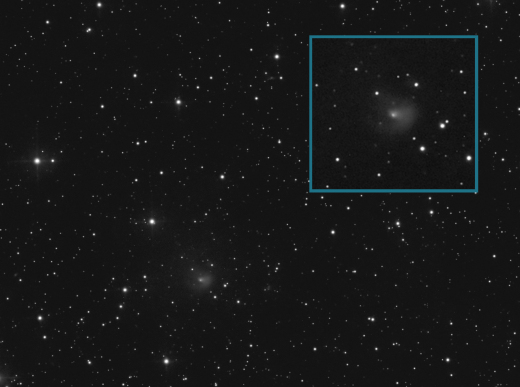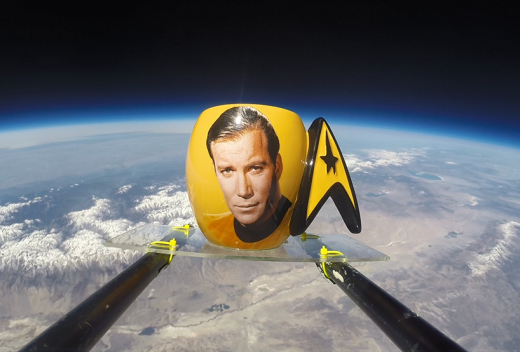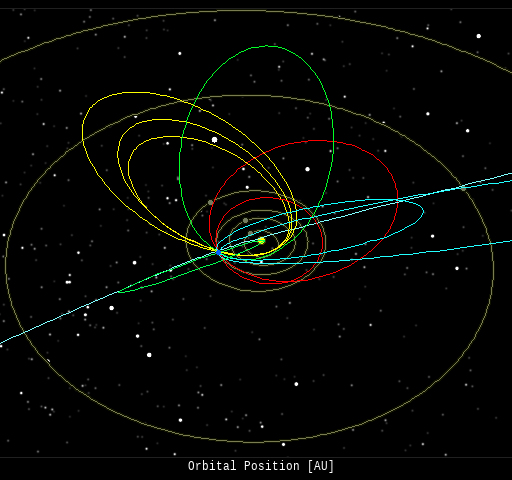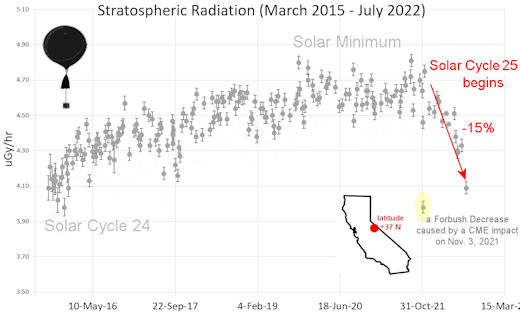 | | | Switch to: Europe, USA, New Zealand, Antarctica Credit: NOAA/Ovation  Planetary K-index Planetary K-index
Now: Kp= 1.33 quiet
24-hr max: Kp= 3.00 quiet
explanation | more data
Interplanetary Mag. Field
Btotal: 5.60 nT
Bz: 5.09 nT north
more data: ACE, DSCOVR
Updated: Today at 1146 UT  Coronal Holes: 11 Apr 23 Coronal Holes: 11 Apr 23 
There are no large coronal holes on the Earthside of the sun.Credit: SDO/AIA  Noctilucent Clouds Noctilucent Clouds
Bad news: NASA's AIM spacecraft, which monitors noctilucent clouds, may be dead due to problems with an onboard battery. Mission controllers have not yet given up all hope, so stay tuned. Switch view:Ross Ice Shelf, Antarctic Peninsula, East Antarctica, Polar Updated Apr11  SPACE WEATHER
NOAA Forecasts | | Updated at: 2023 Apr 11 2200 UTC FLARE | 0-24 hr | 24-48 hr | CLASS M | 45 % | 45 % | CLASS X | 10 % | 10 % |  Geomagnetic Storms: Geomagnetic Storms:
Probabilities for significant disturbances in Earth's magnetic field are given for three activity levels: active, minor storm, severe storm Updated at: 2023 Apr 11 2200 UTC Mid-latitudes | 0-24 hr | 24-48 hr | ACTIVE | 25 % | 15 % | MINOR | 10 % | 05 % | SEVERE | 01 % | 01 % | High latitudes | 0-24 hr | 24-48 hr | ACTIVE | 15 % | 15 % | MINOR | 25 % | 25 % | SEVERE | 40 % | 20 % | | | |  | | | | | | | | | | | Never miss another geomagnetic storm. Sign up for Space Weather Alerts and you'll receive a text message when magnetic storms erupt. Aurora tour guides and professional astronomers use this service. You can, too! | | | GLANCING-BLOW CME DUE TODAY: NOAA forecasters say that a CME might deliver a glancing blow to Earth's magnetic field today. It left the sun on April 7th, propelled an an erupting filament of magnetism. Minor geomagnetic storms are possible if/when the CME arrives. Aurora alerts: SMS Text. CRYOVOLCANIC ERUPTION ON COMET 29P: Over the years, astronomers have observed hundreds of cryovolcanic eruptions on Comet 29P/Schwassmann-Wachmann. Icy gases burst out of the comet's crust at unpredictable times, multiplying its size and brightness 10-fold or more. "I just photographed gases expanding from a strong eruption on April 2nd," says Pepe Manteca of Begues, Catalunya, Spain: 
"This comet is so interesting!" he says. Out of all the eruptions researchers have seen, this one may be different. Why? Because they predicted it. "We have been watching 29P especially closely because [on April 1st] the pseudo-nucleus became very faint indicative of the crust sealing and preventing outgassing," says Dr. Richard Miles of the British Astronomical Association (BAA). "It was the faintest we had ever seen it." Miles and colleagues considered an eruption to be "highly likely" and, indeed, the comet erupted while they watched. It blew like a cork popping from a champagne bottle. Astronomers Maria Eleftheriou and Jose Manuel Perez Redondo caught the eruption in progress on April 2nd using the 2.0-m Faulkes Telescope South. Pepe Manteca's photo shows the debris one week later. Amateur astronomers who wish to help monitor this eruption can find 29P in the constellation Gemini, right here. more images: from Andrea Aletti and Federico Bellini of G.V. Schiaparelli Observatory, Campo dei Fiori Mount, Varese - Italy Realtime Space Weather Photo Gallery
Free: Spaceweather.com Newsletter WHERE NO MUG HAS GONE BEFORE: There's nothing like morning coffee in a cup from space. See for yourself with a rare ceramic Capt. Kirk mug. This one flew to the stratosphere onboard an Earth to Sky Calculus cosmic ray balloon, floating 97,438 feet above the Sierra Nevada mountains of central California:

You can have it for $170.10. That's the serial number of the Enterprise divided by 10. The students are selling Star Trek mugs to support their cosmic ray ballooning program. Each one holds 16 oz. of steaming hot Raktajino (Klingon coffee) and comes with a greeting card showing the collector's item in flight. Far Out Gifts: Earth to Sky Store
All sales support hands-on STEM education
Realtime Aurora Photo Gallery
Free: Spaceweather.com Newsletter Every night, a network of NASA all-sky cameras scans the skies above the United States for meteoritic fireballs. Automated software maintained by NASA's Meteoroid Environment Office calculates their orbits, velocity, penetration depth in Earth's atmosphere and many other characteristics. Daily results are presented here on Spaceweather.com. On Apr 11 2023, the network reported 10 fireballs.
(10 sporadics)  In this diagram of the inner solar system, all of the fireball orbits intersect at a single point--Earth. The orbits are color-coded by velocity, from slow (red) to fast (blue). [Larger image] [movies] Potentially Hazardous Asteroids ( PHAs) are space rocks larger than approximately 100m that can come closer to Earth than 0.05 AU. None of the known PHAs is on a collision course with our planet, although astronomers are finding new ones all the time. On April 11, 2023 there were 2325 potentially hazardous asteroids.
 | Recent & Upcoming Earth-asteroid encounters: | Asteroid | Date(UT) | Miss Distance | Velocity (km/s) | Diameter (m) | | 2023 FZ3 | 2023-Apr-06 | 11 LD | 18.8 | 47 | | 2018 FD | 2023-Apr-06 | 16.2 LD | 7.8 | 47 | | 2023 FE4 | 2023-Apr-06 | 9.6 LD | 2.6 | 31 | | 2023 FM | 2023-Apr-06 | 7.8 LD | 15.8 | 149 | | 2020 FL4 | 2023-Apr-06 | 14.1 LD | 5 | 14 | | 2023 GJ | 2023-Apr-07 | 1.8 LD | 12.1 | 16 | | 2023 FX13 | 2023-Apr-09 | 8.2 LD | 13.3 | 27 | | 2023 FY13 | 2023-Apr-09 | 18.5 LD | 11.9 | 55 | | 2023 FP5 | 2023-Apr-09 | 10.7 LD | 14.1 | 40 | | 2023 FC4 | 2023-Apr-09 | 19.6 LD | 10.1 | 57 | | 2023 FG5 | 2023-Apr-10 | 9.5 LD | 9.4 | 25 | | 2023 FT1 | 2023-Apr-10 | 19.5 LD | 6.6 | 34 | | 2023 GG | 2023-Apr-11 | 4 LD | 10.6 | 75 | | 2023 GQ | 2023-Apr-11 | 0.3 LD | 20.6 | 7 | | 2023 FE5 | 2023-Apr-11 | 11.6 LD | 5.8 | 28 | | 2023 FS10 | 2023-Apr-12 | 3.2 LD | 7.6 | 21 | | 2019 GK21 | 2023-Apr-13 | 15.2 LD | 8.1 | 27 | | 2022 YK9 | 2023-Apr-13 | 19.9 LD | 9.9 | 175 | | 436774 | 2023-Apr-13 | 12.5 LD | 17.6 | 719 | | 2023 FN13 | 2023-Apr-15 | 2.6 LD | 4.5 | 12 | | 2020 BV14 | 2023-Apr-16 | 17.8 LD | 8.2 | 81 | | 2020 FQ6 | 2023-Apr-16 | 13.1 LD | 9.7 | 36 | | 2023 GM | 2023-Apr-17 | 8.5 LD | 20.1 | 115 | | 2023 GO | 2023-Apr-17 | 18.3 LD | 6.7 | 29 | | 2023 GR | 2023-Apr-18 | 18.7 LD | 9 | 62 | | 2006 HV5 | 2023-Apr-26 | 6.3 LD | 17.4 | 400 | | 2021 JF2 | 2023-Apr-28 | 16.6 LD | 8 | 19 | | 2018 VS6 | 2023-May-01 | 5.2 LD | 11.6 | 14 | | 2011 KY15 | 2023-May-18 | 19.9 LD | 14.3 | 54 | | 2021 JK7 | 2023-May-22 | 16.7 LD | 22.9 | 48 | | 2019 UJ3 | 2023-May-23 | 15.5 LD | 9.8 | 21 | | 2023 CL3 | 2023-May-24 | 18.9 LD | 7.3 | 121 | | 2021 KO2 | 2023-May-29 | 15.8 LD | 13.9 | 9 | | 2012 KP24 | 2023-May-31 | 10.3 LD | 12.4 | 19 | | 2018 KR | 2023-Jun-07 | 6.5 LD | 4.9 | 19 | | 2017 UJ2 | 2023-Jun-07 | 5.3 LD | 5.6 | 2 | Notes: LD means "Lunar Distance." 1 LD = 384,401 km, the distance between Earth and the Moon. 1 LD also equals 0.00256 AU. | | Cosmic Rays in the Atmosphere | SPACE WEATHER BALLOON DATA: Almost once a week, Spaceweather.com and the students of Earth to Sky Calculus fly space weather balloons to the stratosphere over California. These balloons are equipped with sensors that detect secondary cosmic rays, a form of radiation from space that can penetrate all the way down to Earth's surface. Our monitoring program has been underway without interruption for 7 years, resulting in a unique dataset of in situ atmospheric measurements. Latest results (July 2022): Atmospheric radiation is decreasing in 2022. Our latest measurements in July 2022 registered a 6-year low: 
What's going on? Ironically, the radiation drop is caused by increasing solar activity. Solar Cycle 25 has roared to life faster than forecasters expected. The sun's strengthening and increasingly tangled magnetic field repels cosmic rays from deep space. In addition, solar coronal mass ejections (CMEs) sweep aside cosmic rays, causing sharp reductions called "Forbush Decreases." The two effects blend together to bring daily radiation levels down. .Who cares? Cosmic rays are a surprisingly "down to Earth" form of space weather. They can alter the chemistry of the atmosphere, trigger lightning, and penetrate commercial airplanes. According to a study from the Harvard T.H. Chan school of public health, crews of aircraft have higher rates of cancer than the general population. The researchers listed cosmic rays, irregular sleep habits, and chemical contaminants as leading risk factors. A number of controversial studies (#1, #2, #3, #4) go even further, linking cosmic rays with cardiac arrhythmias and sudden cardiac death. Technical notes: The radiation sensors onboard our helium balloons detect X-rays and gamma-rays in the energy range 10 keV to 20 MeV. These energies span the range of medical X-ray machines and airport security scanners. Data points in the graph labeled "Stratospheric Radiation" correspond to the peak of the Regener-Pfotzer maximum, which lies about 67,000 feet above central California. When cosmic rays crash into Earth's atmosphere, they produce a spray of secondary particles that is most intense at the entrance to the stratosphere. Physicists Eric Regener and Georg Pfotzer discovered the maximum using balloons in the 1930s and it is what we are measuring today. | | The official U.S. government space weather bureau | | | The first place to look for information about sundogs, pillars, rainbows and related phenomena. | | | Researchers call it a "Hubble for the sun." SDO is the most advanced solar observatory ever. | | | 3D views of the sun from NASA's Solar and Terrestrial Relations Observatory | | | Realtime and archival images of the Sun from SOHO. | | | information about sunspots based on the latest NOAA/USAF Active Region Summary | | | current counts of failed and deployed Starlink satellites from Jonathan's Space Page | | | Authoritative predictions of space junk and satellite re-entries | | | from the NOAA Space Environment Center | | | fun to read, but should be taken with a grain of salt! Forecasts looking ahead more than a few days are often wrong. | | | from the NOAA Space Environment Center | | | the underlying science of space weather |  | Getting YouTube comments is essential if you want to beat the algorithm! That’s why you need to buy YouTube comments from RealSocialz.com because they offer real USA comments you can customize. |  | BestCSGOGambling is the best site for everything related to CSGO gambling on the web |  | To find reviews of new online casino sites in the UK try The Casino DB where there are hundreds of online casino reviews complete with bonuses and ratings. Alternatively, Online-Casinos.xyz is another massive directory of online casinos listing sites for the UK and Worldwide. Casinos that offer Rupees for bonuses are very generous to Indian players. Find the best online casinos in India at AllCasinos.in Looking for a new online casino? Try Casimpo the new site dedicated to making online casino simple, or check out the new Avenger Slots Casino and Ace Online Casino with over 500 online slots and casino games. |  | When looking for casinos to play online when the weather is bad, you can try casino online trucchi for Italian games. If you are not from Finland you can try the Swedish page Svenska casino online to find suitable games, check out svenskacasinoonline.net. Always check your local laws before playing with real money. |  | Looking for sports betting companies not registered on GamStop? CasinoGap has presented a list of sites not on GamStop available for UK players. Check and bet online! Would you like to bet at sites not using GamStop? Look at a list of NonStopCasino sites for online betting that aren't on GamStop. Top-rated bookmakers ever! | | | These links help Spaceweather.com stay online. Thank you to our supporters! | | | | | | | | |  | |  |   | ©2021 Spaceweather.com. All rights reserved. This site is penned daily by Dr. Tony Phillips. | |

